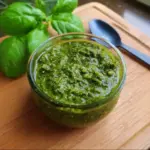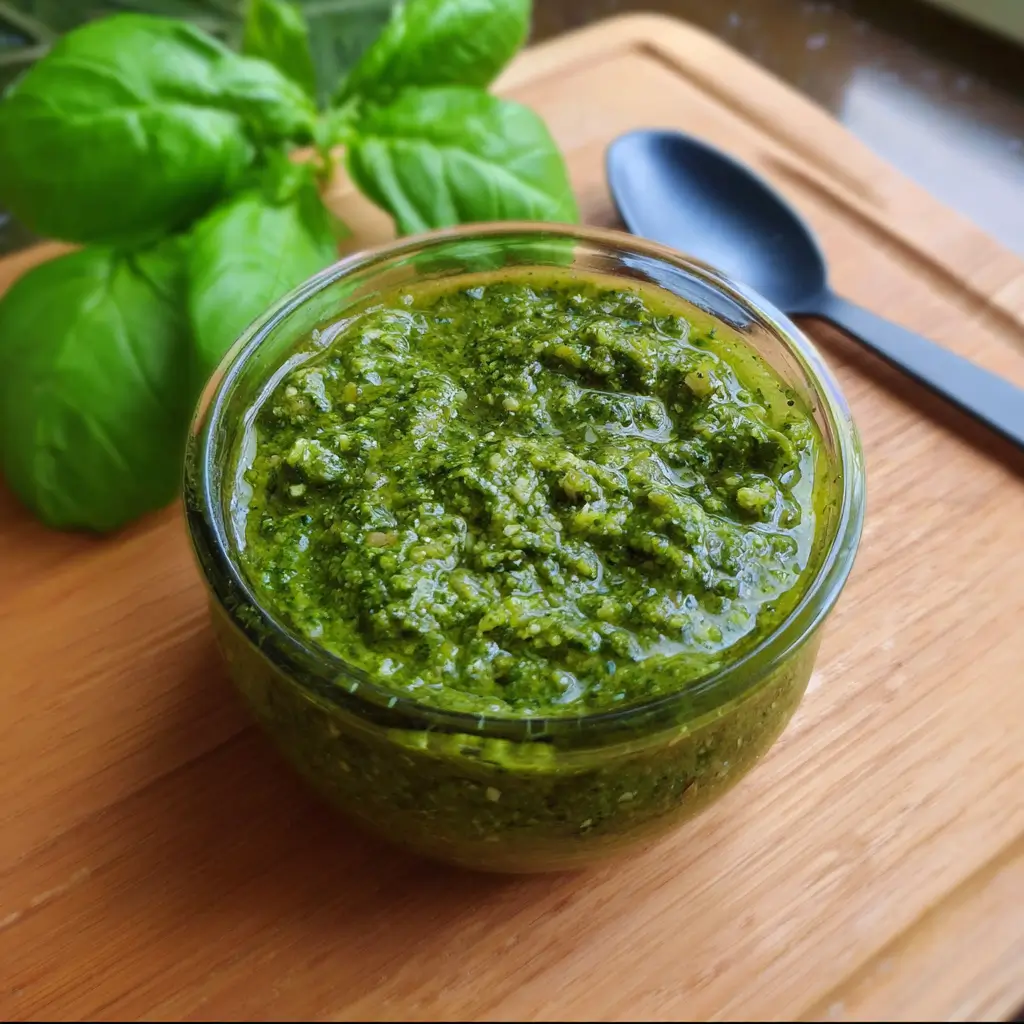Vibrant, aromatic, and bursting with herbaceous flavor, this Fresh Basil Pesto Recipe transforms simple ingredients into a luxurious sauce that elevates any dish it touches. The bright, peppery notes of fresh basil perfectly balance with rich pine nuts, sharp garlic, and nutty Parmesan cheese, creating a symphony of flavors that dance across your palate. This classic Italian condiment has stood the test of time for good reason – it’s incredibly versatile and surprisingly simple to make at home. You’ll learn how to create restaurant-quality Fresh Basil Pesto with perfect texture and balanced flavors that will make store-bought versions pale in comparison.
Why You’ll Love This Recipe
This Fresh Basil Pesto Recipe will quickly become a staple in your cooking repertoire for countless reasons. First, it delivers an unmatched freshness that simply cannot be found in jarred alternatives, with the vibrant basil flavor shining through in every bite. The texture is another standout feature – silky smooth yet with just enough structure to cling beautifully to pasta, spread easily on sandwiches, or drizzle over roasted vegetables.
What truly sets this homemade pesto apart is the perfect balance of ingredients. The peppery basil, creamy pine nuts, sharp garlic, salty Parmesan, and fruity olive oil create a harmonious blend where no single element overpowers the others. Plus, this recipe comes together in just minutes with a food processor, making it accessible even on busy weeknights.
The versatility of this Fresh Basil Pesto is unmatched – beyond the classic pasta application, it transforms grilled chicken, fish, vegetables, and even scrambled eggs into gourmet creations with minimal effort. Best of all, you control the ingredients, allowing you to adjust flavors to your preference and avoid any preservatives or additives.
Ingredients
For this authentic Fresh Basil Pesto Recipe, you’ll need:
- 2 cups (80g) fresh basil leaves, packed but not crushed, stems removed
- 1/2 cup (50g) freshly grated Parmesan-Reggiano or Romano cheese
- 1/3 cup (40g) pine nuts, raw or lightly toasted
- 3 medium garlic cloves (about 9g), peeled
- 1/2 cup (120ml) extra virgin olive oil, preferably cold-pressed
- 1/4 teaspoon (1.5g) fine sea salt
- 1/8 teaspoon (0.3g) freshly ground black pepper
The quality of ingredients is paramount for this recipe. Use the freshest basil possible – look for vibrant green leaves with no dark spots. For authentic flavor, choose true Parmigiano-Reggiano cheese and high-quality extra virgin olive oil, which contributes significantly to the final flavor profile of your homemade basil pesto sauce.
Pro Tips
Achieving perfect Fresh Basil Pesto requires attention to a few critical details that professional chefs swear by:
Blanch Your Basil: For pesto that maintains its vibrant green color, briefly blanch the basil leaves in boiling water for 5-10 seconds, then immediately plunge into ice water. This quick process deactivates the enzymes that cause browning, ensuring your pesto stays bright green even after days in the refrigerator. Just be sure to thoroughly dry the basil afterward to prevent watery pesto.
Toast Pine Nuts Properly: Lightly toasting pine nuts brings out their nutty flavor and adds complexity to your pesto. Place them in a dry skillet over medium-low heat, shaking frequently until they’re just golden (about 3-5 minutes). Watch them carefully as they can go from perfectly toasted to burnt in seconds. Allow them to cool completely before adding to your processor.
Process Ingredients in the Right Order: For perfect texture, add ingredients to your food processor in stages. Start with garlic and pine nuts, pulse until coarsely chopped, then add basil, salt, and pepper. Pulse again, then add cheese. Only after these ingredients are integrated should you slowly drizzle in olive oil while the processor runs. This method ensures perfect emulsification and prevents the olive oil from becoming bitter from over-processing.
Instructions
Step 1
Prepare your basil by picking the leaves from the stems and washing them gently in cold water. Pat dry thoroughly with paper towels or use a salad spinner, as excess water will dilute your Fresh Basil Pesto. If blanching, have a bowl of ice water ready before briefly dipping the leaves in boiling water for 5-10 seconds, then immediately transferring to the ice bath. Dry completely afterward.
Step 2
Place the garlic cloves in your food processor and pulse 2-3 times until coarsely chopped. Add the pine nuts and pulse several more times until the mixture resembles coarse crumbs. This pre-chopping ensures the garlic is evenly distributed without becoming too strong in your finished pesto.
Step 3
Add the basil leaves, salt, and pepper to the food processor. Pulse about 10-15 times, stopping to scrape down the sides with a rubber spatula, until the basil is broken down but still has some texture. You’re looking for small pieces rather than a puree at this stage.
Step 4
Add the grated Parmesan cheese and pulse 2-3 times to incorporate. The cheese adds body and saltiness to your Fresh Basil Pesto Recipe, so it’s important to distribute it evenly before adding the oil.
Step 5
With the food processor running, slowly drizzle the olive oil through the feed tube in a steady stream. Continue processing until the pesto reaches your desired consistency – about 15-20 seconds for a traditional texture. For a smoother pesto, process a bit longer, but avoid over-processing which can make the olive oil bitter.
Step 6
Taste your Fresh Basil Pesto and adjust seasonings as needed. If it tastes flat, add a pinch more salt. If it’s too thick, incorporate a little more olive oil. For more intensity, you might add another small clove of garlic or extra Parmesan to balance the flavors.
Variations
The classic Fresh Basil Pesto Recipe serves as an excellent foundation for creative variations that can suit different dietary needs or ingredient availability:
Nut-Free Pesto: For those with nut allergies, substitute pine nuts with sunflower seeds or pepitas (pumpkin seeds) in equal amounts. These seeds provide similar richness and texture while being completely nut-free. The flavor profile will be slightly different but equally delicious.
Budget-Friendly Pesto: Pine nuts can be expensive, so substitute them with walnuts, which offer a comparable buttery quality at a fraction of the cost. You can also create a hybrid basil-spinach pesto by replacing half the basil with baby spinach leaves, stretching your fresh herbs further while adding extra nutrients.
Dairy-Free/Vegan Pesto: Create a completely plant-based version by replacing Parmesan with nutritional yeast (use 3-4 tablespoons) and adding 1 tablespoon of lemon juice for brightness. This variation maintains the umami flavor while being completely dairy-free. For extra creaminess, you can add 1-2 tablespoons of soaked cashews to the mix.
Storage and Serving
Proper storage is essential for maintaining the vibrant flavor and color of your Fresh Basil Pesto. Transfer the freshly made pesto to an airtight container and drizzle a thin layer of olive oil on top to create a protective seal that prevents oxidation. This simple step helps maintain that beautiful green color and fresh flavor. Refrigerate for up to 5 days, or freeze for longer storage.
For freezing, portion your pesto into ice cube trays, freeze until solid, then transfer the cubes to a freezer bag. These individual portions will keep for up to 3 months and can be thawed as needed for quick meal solutions.
When serving, Fresh Basil Pesto truly shines in these versatile applications:
- Toss with hot pasta, adding a splash of pasta cooking water to create a silky sauce that clings to every strand.
- Spread on toasted baguette slices and top with cherry tomatoes and fresh mozzarella for an elevated bruschetta.
- Use as a marinade for grilled chicken or fish, applying just before cooking for bright, herbaceous flavor.
- Swirl into soups just before serving for an instant flavor boost, particularly effective with tomato or minestrone.
FAQs
Why does my pesto turn brown so quickly?
Basil oxidizes rapidly when exposed to air. To prevent browning, blanch the basil briefly before making your Fresh Basil Pesto, always top stored pesto with a layer of olive oil, and add a squeeze of lemon juice which acts as a natural preservative.
Can I make pesto without a food processor?
Absolutely! Traditional Fresh Basil Pesto was made using a mortar and pestle, which actually creates superior texture and flavor. Crush garlic and pine nuts first, then gradually add basil, grinding with circular motions, before incorporating cheese and olive oil.
Is it necessary to toast the pine nuts?
Toasting is optional but recommended as it enhances the nutty flavor in your Fresh Basil Pesto Recipe. If short on time, raw pine nuts work perfectly well, especially if they’re fresh.
Can I use different herbs?
Yes! While it won’t be traditional basil pesto, delicious variations can be made with other herbs like cilantro, parsley, or arugula, following the same proportions and method.
How do I prevent my pesto from being too oily or too dry?
The key is adding olive oil gradually while processing. For perfect Fresh Basil Pesto, start with slightly less oil than the recipe calls for, then add more as needed until you reach your desired consistency. Remember that cold pesto thickens in the refrigerator.
Conclusion
This Fresh Basil Pesto Recipe is Italian simplicity at its finest — a vibrant, aromatic sauce that transforms everyday ingredients into something truly extraordinary. It’s the kind of versatile kitchen staple that effortlessly elevates weeknight pasta dinners, adds depth to sandwiches, and brings professional flavor to grilled proteins with minimal effort. Once you experience the bright, herbaceous flavors of homemade pesto, with its perfect balance of basil, pine nuts, garlic, and cheese, you’ll never reach for the store-bought version again. Make a double batch—you’ll be reaching for this green gold again and again.
Print
Fresh Basil Pesto Recipe
Description
Vibrant homemade pesto in minutes. This recipe will make you wonder why you ever bought the jarred stuff.
Ingredients
- 2 cups – fresh basil leaves, packed, stems removed
- 1/2 cup – freshly grated Parmesan-Reggiano cheese
- 1/3 cup – pine nuts, raw or lightly toasted
- 3 medium – garlic cloves, peeled
- 1/2 cup – extra virgin olive oil
- 1/4 teaspoon – fine sea salt
- 1/8 teaspoon – freshly ground black pepper
Instructions
- Prepare your basil by washing and thoroughly drying the leaves. If blanching, briefly dip in boiling water for 5-10 seconds, then immediately transfer to ice water and dry completely.
- Place garlic cloves in food processor and pulse 2-3 times until coarsely chopped. Add pine nuts and pulse several more times until the mixture resembles coarse crumbs.
- Add basil leaves, salt, and pepper to the food processor. Pulse about 10-15 times, stopping to scrape down the sides, until the basil is broken down but still has some texture.
- Add the grated Parmesan cheese and pulse 2-3 times to incorporate.
- With the food processor running, slowly drizzle the olive oil through the feed tube in a steady stream. Process until desired consistency is reached, about 15-20 seconds.
- Taste and adjust seasonings as needed, adding more salt, pepper, garlic, or cheese to balance flavors.








